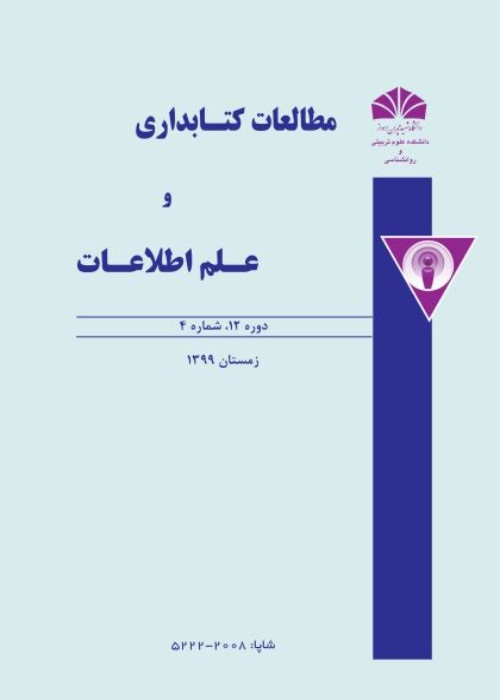The Study of PIM and the Priority of PIM Components of Students:The Case of: Khatem-Al-Anbia Universityof Technology, Behbahan
The main purpose of the present study is to investigate the PIM level and the priority of PIM activities of Behbahan Technological University students. In this survey, the attitudes of students towards the priorities of the students regarding the seven components of Personal Information Management (PIM) and the priorities of items within each component was determined and their activeness in each component was identified.
This survey is of a descriptive-analytical type. Shekari’s (2015) questionnaire was used to collect the data. The reliability of the questionnaire was.089.The population of the survey includes 50 fourth-year undergraduates and 245 masters students, among whom based on Krejci and Morgan table (1970), 181 were selected through stratified random sampling method; 1 to 2.62, respectively. Thus, 50 undergraduate and 131 masters’ students were selected to participate in the survey. To collect the data, Shekari’s (2015) questionnaire was used; which was developed on Jonse’s Model; however, in this study, priority of activities regarding the seven components of Personal Information Management (PIM) were emphasized. The questionnaire consisted of two parts; the first part covered demographic information such as age, gender, and level of education (degree). The second part included 42 questions about “finding information; storage of information; information organization; reserving information; information security; evaluating information; and planning and conceptualization) measured by a Likert five-scale options(extremely high with the score of 5 to extremely low with the score of 1. Of 181 questionnaires distributed, 167 or %92 percent were returned among which 156 questionnaires completed by holders of Masters degree and 109 by holders of postgraduates and were included in the final analyses of the data gathered. Content validity of the questionnaire was approved by 3 teaching staff in the field of Knowledge and Information Science and reliability was determines as 0.89 and acceptable. The Quthe qustionnaires were personally distributed by the researcher. After completion. The questionnaires were collected. To analyze the data, descriptive statistics such as frequency, percent, mean, standard deviation, and also inferential statistics such as One-sample T-test and to rank the components of the variables, Friedman non-parametric ranking, as well as One-way Analysis of Varians (ANOVA) and Multivariate Analysis of variance (MANOVA) were used.
Students’level of PIM is fair (mean=3.21).The first priority was given to “keeping (reserving) electronic information” and “organization of paper documents” with rank means 2.63 and 3.15, respectively. The "security of information" was the second priority in both formats (rank means 3.60 and 3.56, respectively). “Storing information on peripheral devices” with 5.16, and “evaluation of paper documents” with rank mean 4.91, had the highest priorities.
Students use both electronic and paper formats to manage their personal information, and the security of information is of significance in both formats. Regarding the”fair” level of students’ knowledge on PIM, it is recommended to teach PIM components to raise the awareness of students about PIM and to maximize their PIM skills. The results also showed that among the seven components of Information Management, only the component namely ”Information security” was significantly different from “Electronic personal information management” and “Paper personal information management,” (F= 1.946, df= 10, p< 0.05). This difference was in favor of “Electronic personal information management” and in support Shekari’s (2015) finding. It is seen that students are more concerned with “Electronic personal information management” and this type of information management is more important to them. Students are more active in: “Electronic personal information storage”, including storage in proper place, storage for future information needs, and storage on peripheral devices such as C.D., Cool Disk (Flash Memory) than any other activities in this regard. Concerning “Paper personal information management”, “the variable “information evaluation” including “ Sorting(classification) of paper documents, precise control of entry and exit of paper documents into and from the collection of paper personal information, and using explanatory notes to retrieve needed information, were mostly regarded. To sum, it could be said that because the Personal Information Management of students is at the “fair”, this concept and trend is not well recognized by students and most of them despite need to mastering this skill, imperfectly collect, store and organize their personal information and unaware suffer loss of valuable information. Thus, to aware students, training and promoting their performance will help them in this regard. The authors believe that specific actions must be taken to improve students’ personal information management skills as the astonishing ocean of the information available and created each second around the world, according to Simon (cited in Jones and Bruce, 2005) this very massive information causes poor attention and thus poor performance of the people.
- حق عضویت دریافتی صرف حمایت از نشریات عضو و نگهداری، تکمیل و توسعه مگیران میشود.
- پرداخت حق اشتراک و دانلود مقالات اجازه بازنشر آن در سایر رسانههای چاپی و دیجیتال را به کاربر نمیدهد.



